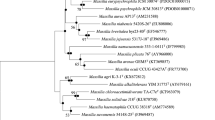Abstract
2-Hydroxynicotinic acid is an important building block for herbicides and pharmaceuticals. Enrichment strategies to increase the chances of finding microorganisms capable of hydroxylating at the C2 position and to avoid the degradation of nicotinic acid via the usual intermediate, 6-hydroxynicotinic acid, were used. Three bacterial strains (Mena 23/3–3c, Mena 25/4–1, and Mena 25/ 4–3) were isolated from enrichment cultures with 6-methylnicotinic acid as the sole source of carbon and energy. Partial characterization of these strains indicated that they represent new bacterial species. All three strains completely degraded 6-methylnicotinic acid, and evidence is presented that the first step in the degradation pathway of strain Mena 23/3–3c is hydroxylation at the C2 position. Resting cells of this strain grown on 6-methylnicotinic acid also hydroxylated nicotinic acid at the C2 position, but did not further degrade the product. Strain Mena 23/ 3–3c showed the highest degree of 16S rRNA sequence similarity to members of the genera Ralstonia and Burkholderia.
Similar content being viewed by others
Author information
Authors and Affiliations
Additional information
Received: 4 April 1997 / Accepted: 10 June 1997
Rights and permissions
About this article
Cite this article
Tinschert, A., Kiener, A., Heinzmann, K. et al. Isolation of new 6-methylnicotinic-acid-degrading bacteria, one of which catalyses the regioselective hydroxylation of nicotinic acid at position C2. Arch Microbiol 168, 355–361 (1997). https://doi.org/10.1007/s002030050509
Issue Date:
DOI: https://doi.org/10.1007/s002030050509




